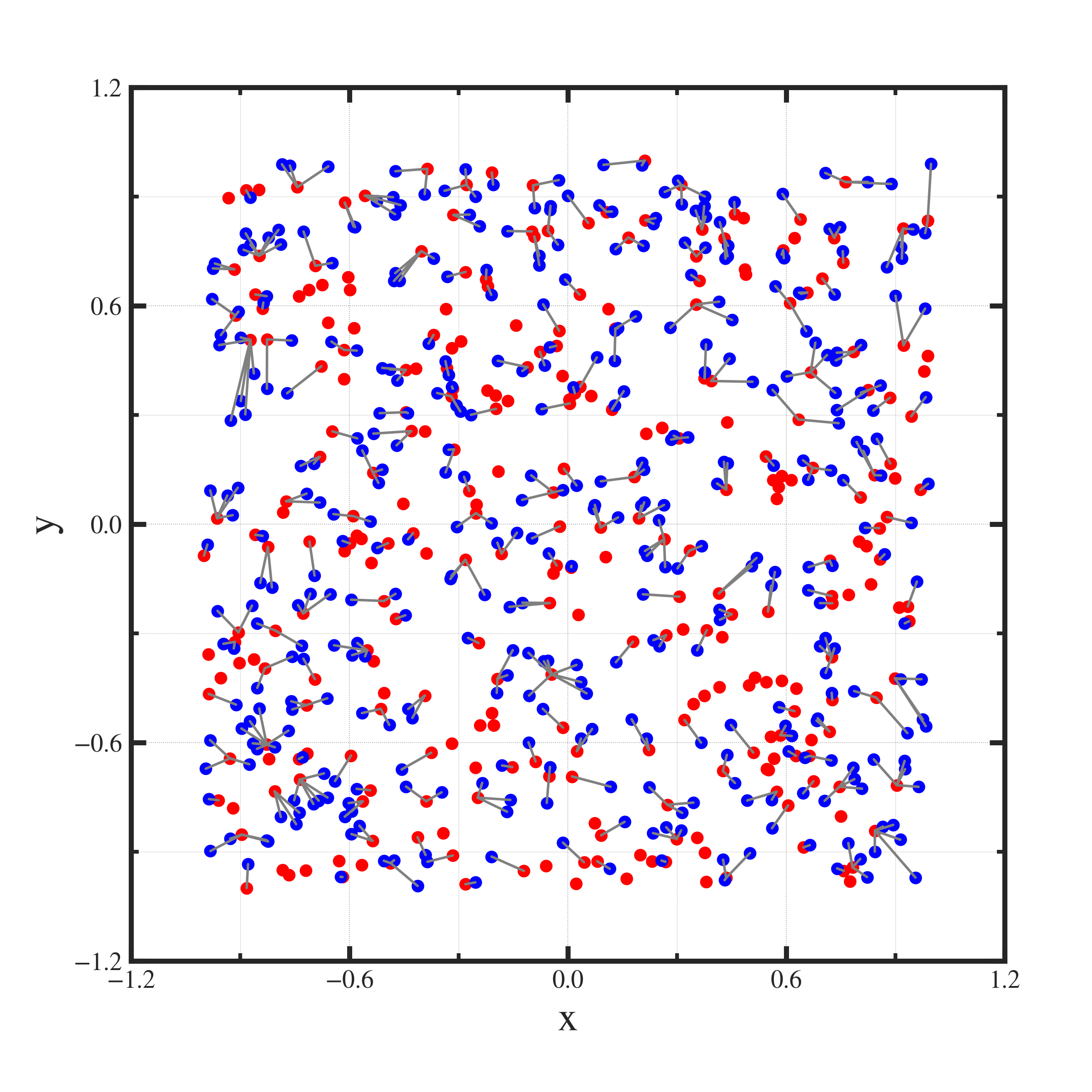最近傍点の探索 ( Blute-Force Attack )¶
Blute-Force Attack による最近傍点の探索¶
最近傍点を探す方法は色々とある.
k近傍法
kd-Tree
etc.
最も Primitive な手法が、総当たりで座標点間の距離を計算し、最小値を捜索するという手法
次元数が増えるほど、データ点数が増えるほど、計算時間が増える.
逆に言うと小さい組み合わせ数なら、速いし問題ない.
Blute-Force Attackの最近傍点探索のコード¶
コードは以下である.
search__nearestPoint.py¶import numpy as np import os, sys import cv2 # ========================================================= # # === search__nearestPoint.py === # # ========================================================= # def search__nearestPoint( vec1=None, vec2=None, returnType="index-distance", foreach=1 ): # ------------------------------------------------- # # --- [1] arguments --- # # ------------------------------------------------- # if ( vec1 is None ): sys.exit( "[search__nearestPoint.py] vec1 == ???" ) if ( vec2 is None ): sys.exit( "[search__nearestPoint.py] vec2 == ???" ) if ( vec1.ndim == 1 ): vec1 = vec1[:,None] if ( vec2.ndim == 1 ): vec2 = vec2[:,None] if ( vec1.shape[1] != vec2.shape[1] ): print( "[search__nearestPoint.py] vec1 & vec2 have different number of dimension." ) print( "[search__nearestPoint.py] vec1'shape :: {} ".format( vec1.shape ) ) print( "[search__nearestPoint.py] vec2'shape :: {} ".format( vec2.shape ) ) sys.exit() else: nLen1 = vec1.shape[0] nLen2 = vec2.shape[0] nDims = vec1.shape[1] if ( foreach == 2 ): axis = 0 # -- compress vec1 -- # elif ( foreach == 1 ): axis = 1 # -- compress vec2 -- # else: print( "[search__nearestPoint.py] foreach must be [ 1, 2 ].... but foreach == {} [ERROR] "\ .format( foreach ) ) # ------------------------------------------------- # # --- [2] calculate distance --- # # ------------------------------------------------- # diff = np.zeros( (nLen1,nLen2,nDims) ) for ik in range( nDims ): g1,g2 = np.meshgrid( vec1[:,ik], vec2[:,ik], indexing="ij" ) diff[:,:,ik] = g1 - g2 dist = np.sqrt( np.sum( diff**2, axis=2 ) ) # ------------------------------------------------- # # --- [3] find minimum distance --- # # ------------------------------------------------- # index = np.argmin( dist, axis=axis, keepdims=True ) distance = np.take_along_axis( dist, index, axis=axis ) index = np.reshape( index , (-1,) ) distance = np.reshape( distance, (-1,) ) # ------------------------------------------------- # # --- [4] return --- # # ------------------------------------------------- # if ( returnType.lower() in [ "distance" ] ): ret = distance elif ( returnType.lower() in [ "index" ] ): ret = index elif ( returnType.lower() in [ "index-distance" ] ): ret = ( index, distance ) return( ret ) # ========================================================= # # === Execution of Pragram === # # ========================================================= # if ( __name__=="__main__" ): vMin, vMax = -1.0, +1.0 vec1 = np.random.random( (300, 2) ) * ( vMax -vMin ) + vMin vec2 = np.random.random( (400, 2) ) * ( vMax -vMin ) + vMin print( vec1.shape, vec2.shape ) returnType = "index-distance" index, distance = search__nearestPoint( vec1=vec1, vec2=vec2, returnType=returnType, foreach=2 ) print( index.shape, distance.shape ) # ------------------------------------------------- # # --- [2] draw test map --- # # ------------------------------------------------- # x_, y_, z_ = 0, 1, 2 import nkUtilities.plot1D as pl1 import nkUtilities.load__config as lcf import nkUtilities.configSettings as cfs pngFile = "png/test.png" config = lcf.load__config() config = cfs.configSettings( configType="plot.def", config=config ) config["plt_xAutoRange"] = False config["plt_yAutoRange"] = False config["plt_xRange"] = [ vMin-0.2, vMax+0.2 ] config["plt_yRange"] = [ vMin-0.2, vMax+0.2 ] fig = pl1.plot1D( config=config, pngFile=pngFile ) fig.add__plot( xAxis=vec1[:,x_], yAxis=vec1[:,y_], color="Red" , linestyle="none", marker="o" ) fig.add__plot( xAxis=vec2[:,x_], yAxis=vec2[:,y_], color="Blue", linestyle="none", marker="o" ) for ik,conn in enumerate( index ): xAxis = np.array( [ vec1[conn,x_], vec2[ik,x_] ] ) yAxis = np.array( [ vec1[conn,y_], vec2[ik,y_] ] ) fig.add__plot( xAxis=xAxis, yAxis=yAxis, color="Grey", linestyle="-" ) fig.set__axis() fig.save__figure()

